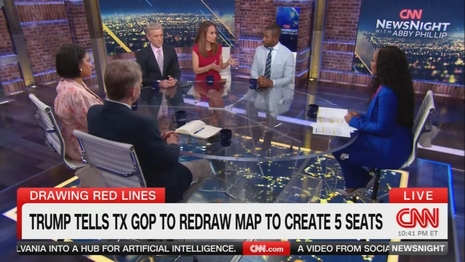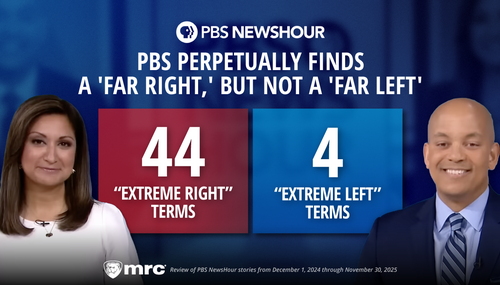On the July 15 broadcast of CNN NewsNight, host Abby Phillip and far-left former MSNBC host Tiffany Cross denounced Texas’s mid‑decade redistricting as “racial gerrymandering,” citing the claim that 95 percent of Texas’s growth since 2010 came from Black and Hispanic residents, and gerrymandering would undermine the voting power of minorities on the cusp of midterm elections.
Phillip opened the segment by saying Trump wanted to destroy Texas’s congressional districts:
The last time Donald Trump tried to redraw a map, he did it with a Sharpie. This time he wants to do it for the ballot box. The President is telling Texas to essentially blow up their congressional maps to find as many as five seats for Republicans ahead of the midterms.
As the segment unfolded, the audience was shown a clip of Donald Trump at the White House earlier in the day. When asked by a reporter about congressional seats in Texas, President Trump stated: “…five. I think we get five, and there could be some other states. We're going to get another three or four or five in addition. Texas would be the biggest one, and that'll be fine.”
This, like anything the President has done, prompted seething outrage from Democrats, with House Minority Leader Hakeem Jeffries asserting, “What Republicans are trying to do in Texas is to have politicians choose their voters to undermine free and fair elections.”
This clip prompted Cross to insinuate that Texas had a “long history” of not following the Voting Rights Act of 1965. The only example given by Cross of this was a SCOTUS reversal of Sections Three and Five of the Act, which the Court deemed outdated. The two Sections gave the Judicial Branch the power to control voting in states deemed likely to not comply with the Act when it was first enacted– a reasonable concern of the Court at a time when there was real racial and oftentimes violent discrimination at the polls in the 1960s, but not so much in the Year of our Lord 2025.
The court felt it was an overreach of the government, so they abolished the Section. However, Cross still insinuated that somehow Texas had something to do with this reversal (despite the case coming from Alabama), implicitly setting the foundation for her further claims of Texas’s racism problem.
Liberals have often accused Texas of having discriminatory voting practices by having one of the strictest voter ID laws in the country. Democrats argue that the required forms of identification were difficult for minorities to obtain. The list of acceptable forms of ID to vote in Texas were:
- Texas Driver License issued by the Texas Department of Public Safety (DPS)
- Texas Election Identification Certificate issued by DPS
- Texas Personal Identification Card issued by DPS
- Texas Handgun License issued by DPS
- United States Military Identification Card containing the person’s photograph
- United States Citizenship Certificate containing the person’s photograph
- United States Passport (book or card)
Despite liberal whining about racial discrimination, the data from Texas tells a different story. Turnout increased more in Texas after introducing photo ID requirements than in states without such laws, with minority turnout rising as fast or faster than white turnout. Texas’s ID law was free, easy to access, and modeled on decades-old practices. The Texas Secretary of State found “no evidence” of racial disparities in turnout due to ID laws.
That did not stop Cross from claiming that Trump encouraged Texas to redistrict right before the midterms to undermine minority voices, citing that 95 percent of the population growth in Texas was from “black and brown” people in the last census.
From April 2010 to April 2020, Texas’s population climbed from 25.15 million to 29.15 million, adding about 3.99 million people— roughly a 16 percent increase. Hispanic growth accounted for about 2.06 million of that increase, and Black population growth was around 667,000. Together, that’s about 68.3 percent of the growth, not 95 percent. The often-cited 95 percent includes all minorities, including Asians and multiracial individuals, but lumping it all together and implying its solely Black and Hispanic growth is misleading.
 Phillip and Cross seized on the 95 percent figure to label the redistricting effort as “racial gerrymandering.” Tiffany Cross declared, “It is because the last census told us that from 2010 to 2020, that 95 percent of Texas's population increase has been because of black and brown people in the state. And so when you redraw the congressional maps, you may have more people voting, but they're voting in gerrymandered congressional districts.”
Phillip and Cross seized on the 95 percent figure to label the redistricting effort as “racial gerrymandering.” Tiffany Cross declared, “It is because the last census told us that from 2010 to 2020, that 95 percent of Texas's population increase has been because of black and brown people in the state. And so when you redraw the congressional maps, you may have more people voting, but they're voting in gerrymandered congressional districts.”
She further warned: “This is why I get so frustrated when people say, oh, just hang on until midterms. As if that's going to change anything. This is an example of a long, storied history in this country of manipulating the electoral process.”
Redistricting was not some novel scheme or uniquely malicious act, like Cross implied. It was constitutionally mandated every ten years under Article I, Section 2.
Scott Jennings pointed out the hypocrisy. When asked what the redistricting by Republicans before a midterm signified, Jennings retorted: “Well, probably the same thing that it signifies when they did it in Illinois and got a 14-3 delegation for D's, Maryland seven to one, Massachusetts nine to zero. We know what happened here in New York, California— even though they have a commission, we all know what goes on there.” When Phillip pressed about the midterm timing, Jennings responded, “Does it matter?” underscoring that Democrats routinely redraw maps to their advantage, like in North Carolina in 2022 which flipped a solid red district to a Democratic majority.
On voter ID, critics argue it suppresses minority votes. The data from Texas tells a different story. Turnout increased more in Texas after introducing photo ID requirements than in states without such laws. Texas’s ID law was easy to access, and modeled on decades-old practices. The Texas secretary of state found “no evidence” of racial disparities in turnout due to ID laws.
Trump’s call to pick up five seats was a political strategy, not proof of racial animus. The 2020 Census awarded Texas two new congressional seats, reflecting genuine population growth. As Trump explained to CBS News, “No, no. Just a very simple redrawing. We pick up five seats.”
Yes, redistricting can be abused. But the claims that Trump and Texas were engaging in racial gerrymandering and overexaggerate figures to fit a narrative was absurd.
The entire transcript is below. Click "expand" to read.
CNN NewsNight With Abby Phillip
July 15, 2025
10:35:08 PM ETABBY PHILLIP: The last time Donald Trump tried to redraw a map, he did it with a Sharpie. This time he wants to do it for the ballot box. The President is telling Texas to essentially blow up their congressional maps to find as many as five seats for Republicans ahead of the midterms.
[SCREEN WIPE TO INTERVIEW]
PRESIDENT DONALD TRUMP: …five. I think we get five, and there could be some other states. We're going to get another three or four or five in addition. Texas would be the biggest one, and that'll be fine.
ED O’KEEFE (CBS News): So are you– are you calling in for a complete redrawing of the congressional map?
TRUMP: No, no. Just a very simple redrawing. We pick up five seats. [Transition] A couple of other states where we'll pick up seats also.
[CUT TO LIVE]
PHILLIP: Democrats are calling the move desperate and unconstitutional.
[SCREEN WIPE TO PRESS CONFERENCE]
HOUSE MINORITY LEADER HAKEEM JEFFRIES (NY-D): In this country, public servants should earn the votes of the people that they hope to represent. What Republicans are trying to do in Texas is to have politicians choose their voters to undermine free and fair elections.
[BACK TO LIVE]
PHILLIP: So what does it signify that Republicans, ahead of the midterms, believe that– that it's going to be so necessary to get an upper hand that they have to actually redraw an entire state's congressional maps in order to get five seats out of it?
SCOTT JENNINGS: Well, probably the same thing that it signifies when they did it in Illinois and got a 14-3 delegation for D's, Maryland seven to one, Massachusetts nine to zero. We know what happened here in New York, California– even though they have a commission, we all know what goes on there.
PHILLIP: In the–
JENNINGS: All these blue states–
PHILLIP: In the mid-cycles specifically–
JENNINGS: All these blue states–
PHILLIP: Are all of those cases in mid-cycles?
JENNINGS: All of these cases are where Democrats use the power they have–
PHILLIP: Yeah but–
JENNINGS: –to give them an advantage.
PHILLIP: But just to be clear, because I– I didn't do the research that you did in the break here, is it that they're changing it after the actual census process where you're supposed to create a, you know, you're supposed to go through the congressional redistricting process?
JENNINGS: Does it matter?
PHILLIP: It kinda does.
[CROSSTALK]
PHILLIP: I think that’s the whole point is that–
JENNINGS: So it's okay for Democrats to lopside these things? –
PHILLIP: No, no, no. I meam– look.
JENNINGS: these states? Nine-nothing in Massachusetts.
PHILLIP: Here’s what I will say about this–
JULIE ROGINSKY: Find me a Republican who can get elected in Massachusetts.
PHILLIP: You know, Texas actually has done this before. So, you’re right that it’s not new, but the point is, is that it's unusual. And they're doing it because the midterms are coming. And it seems to suggest that there's a weakness that they're anticipating, and they want to get ahead of it.
TIFFANY CROSS: It's not just because the midterms are coming. It is because the last census told us that from 2010 to 2020, that 95 percent of Texas's population increase has been because of black and brown people in the state. And so when you redraw the congressional maps, you may have more people voting, but they're voting in gerrymandered congressional districts.
This is why I get so frustrated when people say, oh, just hang on until midterms. As if that's going to change anything. This is an example of a long, storied history in this country of manipulating the electoral process. And we're seeing it play out right before our eyes in Texas. It has a-- gerrymandering that is not illegal. Racial gerrymandering certainly is. And this is exactly what's happening, since SCOTUS obliterated Section Three and Section Five of the Voting Rights Act, of which Texas has a long history of violating.
(...)




